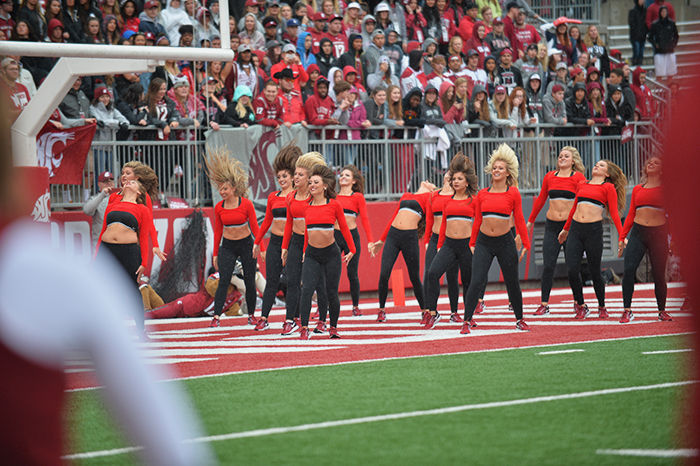Crimson Girls should reflect WSU’s diversity
The WSU Crimson Girls perform at the beginning of the second quarter during the Sept. 17 University of Idaho game at Martin Stadium.
December 12, 2016
It’s the Apple Cup – you’re having a good time at the game, celebrating WSU pride against our biggest rivals, the University of Washington. When the second quarter rolls around, you’re waiting with everyone else for a performance from the Crimson Girls, a dance team part of WSU’s spirit squad.
At this year’s Nov. 25 game, the Crimson Girls performed a routine to the songs “Push It” and “Shoop” by the hip-hop trio Salt-N-Pepa. A black female group from Queens, New York, Salt-N-Pepa are known for their groovy hip-hop choreography and were active throughout the ‘80s and ‘90s.
Although the playlist of the Crimson Girls’ routine is made up of artists who are people of color, their actual team is not. For the academic year 2016-2017, the Crimson Girls team does not appear to represent WSU’s diversity.
American popular culture is heavily influenced by people of color. Our society, on the other hand, lacks appreciation for the significant contributions people of color have made to popular culture. These contributions have manifested in a variety of genres including hip-hop, rap, jazz, rock ‘n’ roll, classical and country.
In addition to hip-hop music, hip-hop dance is a genre predominantly founded by black and brown people in the 1960s. Today, many dance, cheer and art groups appropriate hip-hop culture and music without regard for inclusion.
There is a thin line between engaging in works of art and mainstream culture, and appropriating them without due merits.
I’m not arguing that black music should not be utilized by members of a dominant society in things like dance. However, more efforts toward representation and diversity should be made by art groups and teams like the Crimson Girls.
The team, like all sub-institutions and groups, should reflect the nature of our world in general: diverse.
According to WSU Quick Facts, multicultural students make up 29 percent of the student population in Pullman alone. In theory, the Crimson Girls dance team should reflect these proportions, meaning that at least a quarter of the team should be visibly identifiable as women of color.
Unless we operate under the notion that black and brown women can’t dance — which is obviously untrue — there should be black and brown women front and center in the Crimson Girls.
Equal representation is not only important because seeing different colors is fun, but because it’s accurate to what our society consists of and is essential to the de-stigmatization of people of color in our society.
It’s important to see black girls jukin’ and jivin’ to music made by people who look like them.
It’s important that all institutions create a conscience effort to diversify its members if we are to continue moving toward a post-racial society.
Kaila Evenoff, head coach of the Crimson Girls, is adamant that the dance team consists of a diverse group of women with different backgrounds and different paths.
“I feel like we are pretty diverse,” Evenoff said. “Just because the color of our skins doesn’t necessarily make us look like it doesn’t mean we are not a diverse group of women.”
Evenoff pointed out there’s three girls on the team with ethnically diverse heritage: one girl who’s half Japanese and another two girls who have African-American and Indian heritage.
“Most people associate diversity with the color of our skin,” Evenoff said, “but what makes us diverse as well is the fact that we all have different backgrounds and paths.”
However, having different majors and career goals is not an indication of diversity in the context of race, ethnicity and other social categories.
It’s dubious that during auditions, every single black and brown woman who auditioned simply did not meet the standards to be a Crimson Girl. I personally know several phenomenal dancers who are women of color and who attend WSU.
In fact, WSU dance groups like Detour and Group Effort are evident that Pullman isn’t experiencing a shortage of exceptional student dancers who are people of color. It’s unfortunate this diversity is not reflected at our football games and other athletic events.
Greater efforts should be made toward attracting more people to auditions in the hopes of having a more diverse turn out.
As of right now, auditions are advertised through the Crimson Girls’ social media or on the WSU Cougars website, which you would only see if you were already interested in the team. There should be greater visibility on campus through tabling, flyers and more to ensure diversity.
Cougs are not just white females. Cougs are black and brown and multicultural. We should see this when we are in the stands waiting for the Crimson Girls to remind us how much spirit we have and how amazing WSU is.
Basheera Agyeman is a junior comparative ethnic studies major from Accra, Ghana. She can be contacted at 335-2290 or by [email protected]. The opinions expressed in this column are not necessarily those of the staff of The Daily Evergreen or those of The Office of Student Media.
Editor’s note: This column has been revised to clarify that there are some women of ethnically diverse heritage on the Crimson Girls team.



















